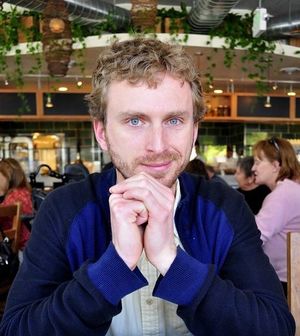John Long: Difference between revisions
From Santa Fe Institute Events Wiki
No edit summary |
No edit summary |
||
| Line 8: | Line 8: | ||
Questions of particular interest to me while I'm here at the Santa Fe Institute are: | Questions of particular interest to me while I'm here at the Santa Fe Institute are: | ||
* How can a system differentiate changes in its sensory input caused by self-motion from those arising from dynamics in the environment? | |||
* How can a system learn to associate dynamic models with space, e.g. a viscosity change due to entering water, versus changes in its plant, e.g. fatigue or damage? | |||
Revision as of 04:44, 4 June 2012

I am a post-doc in the laboratory of Gyorgy Buzsaki at New York University. My interests are in neuroscience and robotics. My work in neuroscience involves investigating the role of the hippocampus in mediating the transition between exploratory and exploitative behaviors during random foraging in rats. My methods combine recordings of large-scale neuronal firing patterns within the dorsal CA3-CA1 pathway with behavioral data collected by a markerless motion capture system. My goal is to explicate which neural mechanisms mediate the transitions between these behaviors as rats learn and memorize the location of multiple rewards within an open environment. Decades of research has revealed the rat hippocampus forms so-called "place field maps", of the environment, which are invariant to both the subject's kinematics and dynamics. How these maps are formed is an open question. My approach aims to contribute to both basic empirical science and technology development through biomimicry.
My development of a markerless motion capture system provides us with a complete picture of the subjects’ kinematics as they forage for reward. This enables to us analyze the fine details of exploratory and exploitative behavior beyond what has currently been achieved in the field (basic position and orientation tracking). Together, these data open up a vast analysis space as we attempt to relate the moment to moment dynamics of the neural data to the subjects’ foraging behavior.
My research interests have brought me to the Santa Fe Institute for several reasons. With regards to my own work, the detailed behavioral data collected by our motion capture system poses many challenges to analysis e.g. classifying behaviors and relating the dynamics of these to the neural data. Toward this end, I am currently implementing several machine learning techniques for parsing the subjects’ behavior in an unsupervised manner e.g. Infinite Hidden Markov models and Information Clustering. To analyze the neural data, I have employed techniques from Information Theory and Principal Component Analysis to treat the neural data as a whole in relation to behavior, while making the process as computationally efficient as possible. These preliminary analyses have impressed upon me the usefulness of methods from non-linear dynamics and complex systems analysis, which I would like to gain proficiency at while attending the Santa Fe Institute summer course. In particular, techniques for interpreting phase diagrams of complex systems, e.g. recurrence plots, seem promising, and I would like to learn from the faculty at the Institute further techniques for meaningfully applying these to my work.
Lastly, while my experimental work is observational, I am passionately interested in understanding how neural systems realize the computations we observe as behavior. I recognize this requires some theoretical creativity. I consider myself a student of cybernetics and have been developing some ideas regarding neural computation, which I would like to develop while attending the summer course. Broadly, I’m interested in translating the algorithmic models of autonomous spatial localization and mapping--often referred to as SLAM systems--into the dynamic systems context. Here my goal is to merge algorithmic solutions to spatial navigation problems with the robustness offered by a dynamical systems approach. I am currently developing innovative neural network architectures for tackling this problem, and the Santa Fe Institute provides an incredible forum for critiquing and refining my ideas.
Questions of particular interest to me while I'm here at the Santa Fe Institute are:
- How can a system differentiate changes in its sensory input caused by self-motion from those arising from dynamics in the environment?
- How can a system learn to associate dynamic models with space, e.g. a viscosity change due to entering water, versus changes in its plant, e.g. fatigue or damage?
